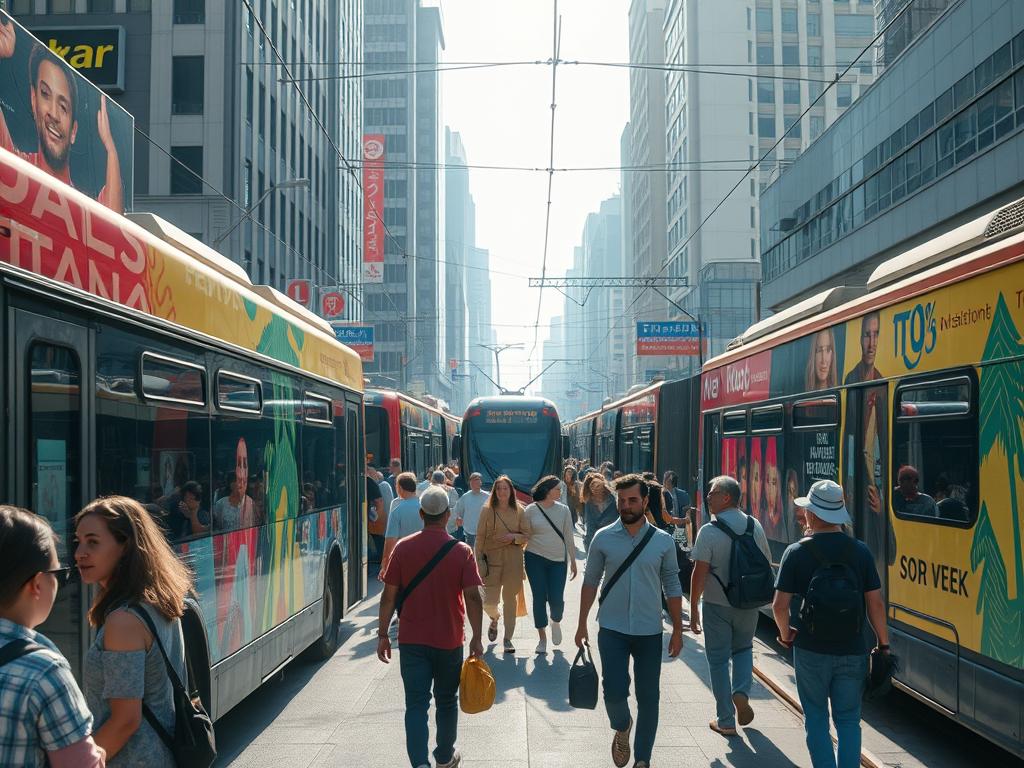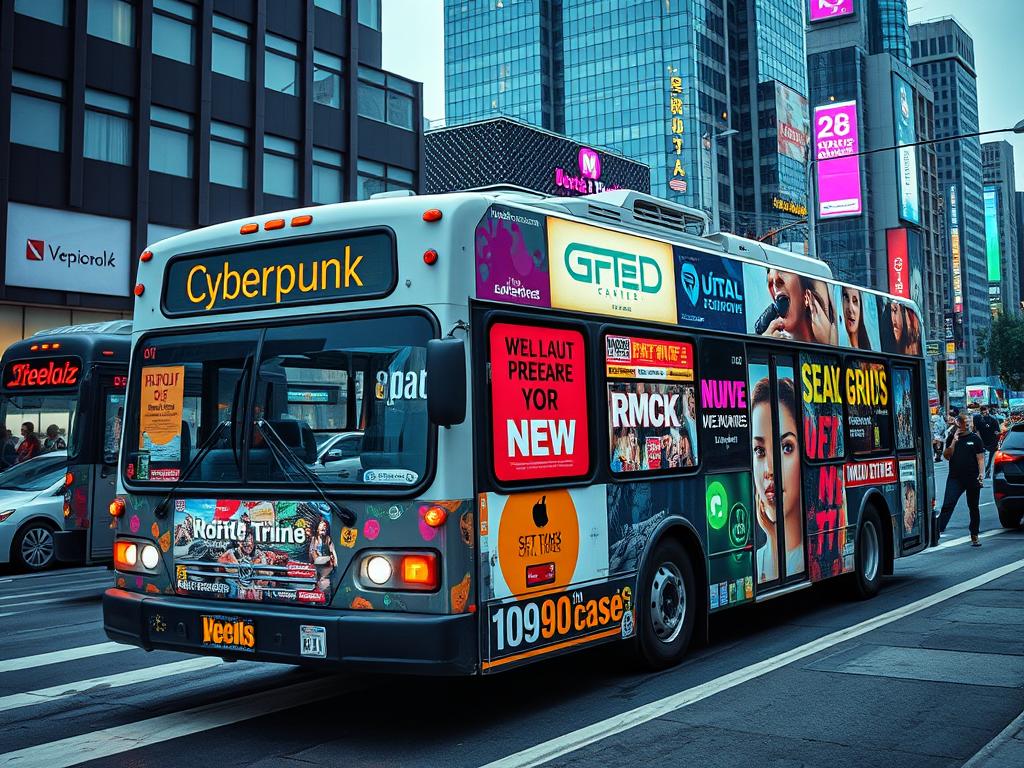Transit advertising refers to the practice of placing ads on or within public transit vehicles or stations, targeting riders and pedestrians with brand messages. It is a form of out-of-home media that leverages public transportation advertising to reach consumers during their commutes.
Whether it’s bus wrap ads covering city buses or mobile billboards cruising through urban areas, transit media solutions ensure your brand receives maximum exposure. For instance, 42% of consumers notice digital ads like taxi top advertisements “all” or “most” of the time. With transit advertising, your message is not just visible; it’s unavoidable.
Effective transit advertising, such as the campaigns offered by rabbittransit, caters to a broad demographic, including both car owners and those reliant on public transport. This medium capitalizes on the significant dwell time of commuters, ensuring that your brand stays in the viewers’ minds long after they’ve seen the ad. According to the American Public Transit Association, transit ads generate over half a billion dollars, underscoring their value in the advertising world.
Understanding Transit Advertising
Transit advertising encompasses a variety of formats within public transportation venues, aimed at reaching passengers and passersby. With origins dating back to the mid-19th Century, it has evolved into a significant component of contemporary marketing strategies. This form of advertising not only targets daily commuters but also those using public transportation occasionally, making brand visibility in transit exceptionally high.
One primary benefit of transit media advertising is its ability to place messages in front of consumers where they can’t easily skip or ignore them. Unlike TV commercials or online ads that can be avoided, marketing on public transport offers unavoidable exposure. This pervasive presence significantly enhances advertising effectiveness, making transit advertising particularly potent in busy urban settings.
Different vehicles provide distinct advantages. For instance, commuter rail advertisements reach a captive audience that commutes daily, thus increasing brand visibility in transit. Similarly, subway ads deliver millions of impressions multiple times a day, especially in cities with extensive commuting times. On the other hand, taxi and rideshare advertising through services like Uber or Lyft can provide high advertising reach due to the mobility and high visibility of these cars.
- Rail advertising reaches commuters in major markets, highly effective for high daily impressions.
- Bus media advertising targets thousands of bus stops nationwide, connecting with diverse demographics.
- Taxi ads offer a cost-effective strategy, useful for widespread visibility in urban areas.
- Rideshare advertising offers modern channels for reaching tech-savvy and active consumers.
In today’s dynamic marketing landscape, new technologies offer innovative ways to enhance advertising effectiveness. Digital screens, dynamic content, and interactive ads in transit spaces engage audiences through visually engaging and easily shareable content. This evolution ensures transit media advertising remains a forward-thinking choice for brands looking to maximize their reach and impact. By aligning their strategies with the demographics of transit riders, businesses can tailor their message to target the right audience effectively.
| Transit Media | Target Audience | Key Benefits |
|---|---|---|
| Rail Advertising | Daily commuters in major markets | High impressions, effective for busy markets |
| Bus Media Advertising | Diverse demographic at bus stops | Wide visibility, reaches isolated communities |
| Taxi Ads | Urban dwellers, pedestrians | Cost-effective, high daily views |
| Rideshare Advertising | Tech-savvy consumers | Modern, high visibility, mobile reach |
The Importance of Transit Advertising
Transit advertising plays a crucial role in modern marketing strategies due to its unique ability to capture daily visibility and engage a widespread audience reach. Unlike other media that can be turned off or skipped, commuter ads are constantly in the line of sight, delivering high visibility and making it difficult to ignore. This constant presence ensures that brands stay top-of-mind among diverse audiences, enhancing the impact of targeted advertising.
High Visibility

One of the major advantages of transit advertising is its ability to achieve high visibility throughout the day. Whether it’s on buses, subways, or at transit stations, these ads are strategically placed to ensure they are viewed by a large number of people. With transit media, your brand can achieve daily visibility, reaching commuters and capturing their attention effectively during their routine journeys. This ensures your message isn’t just seen but also remembered, yielding a lower cost per thousand impressions (CPM) compared to other advertising formats.
Broad and Varied Audience
Transit advertising taps into a broad and varied audience, providing exposure to people from different age groups, backgrounds, and socio-economic statuses. It effectively targets families, tourists, professionals, students, and commuters, offering a vast widespread audience reach that cannot be matched by most other forms of advertising. For instance, transit media in bustling urban areas ensures that your message reaches significant footfall, engaging commuters during their daily travels. This enables a more effective and targeted advertising campaign, boosting overall engagement and brand recall.
By leveraging the inherent strengths of targeted advertising through transit media, advertisers can ensure their campaigns resonate with a diverse demographic. This multifaceted approach not only broadens market reach but also amplifies engagement, ultimately driving better results for businesses.
| Advertising Medium | Visibility | Audience Reach | Cost Efficiency (CPM) |
|---|---|---|---|
| Transit Ads | High | Broad and Varied | Low |
| Digital OOH | Moderate | Targeted | Moderate |
| Static OOH | High | Diverse | Low |
Types of Transit Advertising
Transit advertising has significantly evolved to offer a diverse array of options, which include both traditional print ads and innovative digital displays. From stationary ads to mobile campaigns, businesses can choose from several mediums to effectively engage with their audience.
One of the most popular forms is bus wraps. These large-scale advertisements cover a significant portion of a bus’s exterior, making it highly visible as it travels through various neighborhoods and routes. This method provides 24/7 exposure and allows for geographic targeting of specific areas. With a typical commute lasting between 15 minutes to an hour, bus wraps create multiple opportunities for impressions, raising consumer awareness effectively.
Train ads are another impactful form of transit advertising. These ads are strategically placed inside and on the exterior of trains, where they can capture the attention of commuters who are often on extended trips. Given the longer interaction times associated with train travel, train ads can make a lasting impression. Additionally, scalable ad options can follow the audience from station to train, creating a cohesive marketing experience.
Taxi-top advertising targets urban environments where cabs are prevalent. With cab rides typically lasting around ten minutes, these ads provide consistent exposure within high-profile, bustling city centers.
Mobile billboards, often seen on trucks, are visually stimulating and frequently utilize digital and video components for added impact. These moving ads are eye-catching and can reach thousands of people with a single, well-placed route.
Station advertisements encompass a wide range of ad formats, including billboards and digital screens in subway and train stations. These ads benefit from the high foot traffic in these areas, making them exceptionally effective. For example, subway ads reach a mass audience due to the diverse and densely populated locations of subway stations, providing high visibility inside subway cars.
In summary, transit advertising offers various creative avenues to capture and retain the attention of consumers, from bus wraps to station advertisements.
Benefits of Transit Advertising
Transit advertising persists as a powerful tool in modern marketing, offering several notable benefits to businesses. The ability to capture large, diverse audiences is a key advantage, alongside the sustained exposure that enhances consumer recall and engagement.
Maximize Exposure
By leveraging high-frequency visibility, transit advertising ensures your brand remains front and center in the bustling urban landscape. Effective out-of-home campaigns like bus wraps, train ads, and subway posters blanket the city, continually drawing the eye of commuters. This persistent presence is particularly useful during peak commute hours, when the potential number of impressions soars. Compared to other forms of advertising, transit options generally offer a lower cost per impression, making them an economically viable choice for reaching a wide audience.

Unavoidable Media
Transit advertising’s inherent characteristics make it virtually unavoidable. As commuters navigate crowded streets and public transport systems, well-placed ads are bound to be seen repeatedly. This repetitive exposure reinforces brand awareness and facilitates a stronger, more enduring connection with the audience. Moreover, the static nature of these ads—often displayed for weeks or even months—ensures advertising longevity, maintaining consistent brand visibility without the need for frequent updates. Ultimately, the continuous and conspicuous nature of transit advertising serves as a reliable method to bolster your brand’s recognition in everyday life.
Examples of Effective Transit Advertising Campaigns
Successful transit campaigns demonstrate the power of public transport advertising in increasing brand awareness and engaging a broad audience. In this section, we will explore compelling case studies in transit ads that underline their effectiveness and impact.
One noteworthy campaign is American Express’ geotargeted ads on top of 125 New York City taxis. This initiative displayed location-specific contextual advertising, effectively capturing the attention of commuters and travelers alike. The result was a significant boost in brand visibility and engagement.
Another prime example is the “Tap to Unlock NYC” campaign by the Metropolitan Transportation Authority (MTA). This campaign utilized transit advertising at Grand Central Station and eight other key locations. By strategically placing their message in high-traffic areas, MTA achieved remarkable outreach, demonstrating the potential of impactful public transport advertising.
A digital out-of-home (DOOH) campaign at London Stansted Airport also stands out. It provided live journey time comparisons between different modes of transport, making the ads not only engaging but also useful for the viewers. This innovative use of real-time data ensured that the information was relevant, timely, and highly effective.
| Company | Campaign | Outcome |
|---|---|---|
| American Express | Geotargeted Taxi Ads | Significant boost in brand visibility and engagement |
| MTA | “Tap to Unlock NYC” | Remarkable outreach and high engagement |
| Stansted Airport | Live Journey Time Comparisons | Increased relevance and effectiveness through real-time data |
According to a Nielsen study, 78% of US travelers noticed transit advertising in the last month, underscoring the reach of these campaigns. The Outdoor Advertising Association of America (OAAA) found that 54% of consumers notice transit ads at public transportation areas most or all of the time, illustrating their pervasive visibility.
Moreover, transit advertising increases brand awareness by up to 89% among commuters. With a 44% higher ROI than traditional marketing channels, these ads offer a favorable cost per impression. This makes transit advertising an efficient and economical choice, particularly appealing to small and medium-sized businesses.
Case studies in transit ads clearly show that incorporating real-time data, such as transport updates, weather, traffic, and live news, enhances the engagement and relevance of the ads. The ability to capture audience attention with timely information proves why transit advertising is a formidable tool in any marketing strategy.
Technological Advancements in Transit Advertising
Technological advancements have significantly transformed transit advertising, offering more compelling ways to capture consumers’ attention. From digital screens to interactive ads and dynamic content, the landscape of transit advertising has become more engaging and efficient.
Digital Screens
Digital signage is revolutionizing digital transit advertising, moving away from traditional static billboards to dynamic screens in buses, subways, and transit hubs. These advanced advertising technologies display videos, animations, and real-time data, making ads more engaging and effective. Digital screens capture the eyes of commuters with vivid visuals and can be updated quickly to reflect current promotions or messages.
Interactive Ads
Interactive ads have added a layer of mobile interactivity in transit advertising. Augmented reality (AR) apps on mobile devices are being used in transit ads, offering engaging transit content through scannable QR codes. These interactive experiences allow consumers to engage directly with ads via their smartphones, enhancing the overall passenger experience.
Dynamic Content
Dynamic advertisements utilize motion to create an impression of movement, captivating viewers as they commute. This form of digital transit advertising uses data-driven insights to understand commuter behavior and preferences, optimizing ad placements, timing, and content for maximum impact. Nevertheless, the integration of Wi-Fi and Bluetooth connectivity within transit systems allows advertisers to push relevant content directly to commuters’ devices, ensuring that the ads are both relevant and engaging.
| Technological Feature | Transformation in Advertising |
|---|---|
| Digital Screens | Transition from static billboards to dynamic video and animations |
| Interactive Ads | Enhanced engagement through mobile interactivity and AR experiences |
| Dynamic Content | Data-driven advertising and real-time content delivery to commuters’ devices |
The adoption of advanced advertising technologies such as digital screens, interactive ads, and dynamic content in transit environments has made it possible to deliver highly effective and engaging transit content that captures and retains consumer attention.
Effective Strategies for Transit Advertising
Effective transit advertising requires a blend of strategic media planning, location-based advertising, and demographic targeting. These key components help businesses maximize their reach and create long-lasting impressions. Understanding commuter patterns and selecting prime locations play a critical role in the success of your transit ad campaigns.
One of the primary strategies in transit advertising is engaging in strategic media planning. This involves evaluating various transit routes and identifying the ones that align best with your target audience. Collaborating with experienced agencies like Strategic Marketing, which has over 30 years of experience, can be beneficial. They have collaborated with businesses like Terry Murphy’s for over 20 years and have successfully managed advertising accounts for companies for over a decade.
Location-based advertising is another crucial aspect that ensures your ads are seen by the right people. Millions of people utilize public transportation services daily, making it a valuable medium to reach diverse audiences across different demographics. For instance, leveraging the high engagement levels at airports, where 83% of frequent flyers notice advertisements, could be profitable. It’s also noteworthy that 82% of people recall seeing a DOOH advertisement even a month later, indicating the potency of such ads.
Integrating demographic targeting into your strategy further refines your advertising efforts. This means customizing your advertisements to resonate with specific target groups based on their age, ethnicity, and income level. An example of successful demographic targeting is how Strategic Marketing helped a large, locally owned business in their grand opening in September 2018, providing ongoing support that led to significant brand success.
Another essential factor is crafting creative advertising solutions that captivate and engage your audience. Transit ads have distinct advantages like constant visibility and prolonged engagement, particularly for formats like interior bus ads. The average bus ride lasts around 20 minutes, offering ample time to capture the attention of commuters. Developing visually striking and message-driven ads can significantly contribute to your campaign’s effectiveness.
Transit advertising also allows for geographic targeting, enabling advertisers to reach specific neighborhoods and routes effectively. This approach ensures that your ads are always in front of the right audience, maximizing the impact and value of your advertising spend. Transit advertising is also cost-effective when considering its extensive exposure and lower cost per impression compared to other media forms.
| Advantages | Details |
|---|---|
| High Visibility | Visible 24/7, offering constant public engagement |
| Cost-Effective | Lower cost per impression compared to other advertising forms |
| Prolonged Engagement | Interior bus ads engage commuters for an average of 20 minutes |
| Targeted Reach | Effective geographic targeting to specific neighborhoods and routes |
Combining these strategies—strategic media planning, location-based advertising, demographic targeting, and creative advertising solutions—ensures that your transit advertising campaigns are both impactful and efficient. By understanding and leveraging these elements, businesses can significantly enhance their advertising outcomes and achieve their marketing goals.
Did Transit Advertising Emerge as a Result of the Industrial Revolution?
The rise of factories during the Industrial Revolution led to urbanization, with people congregating in cities. This created a perfect environment for industrial revolution advertising, including transit advertising, as businesses sought new ways to reach consumers traveling on buses, trolleys, and trains in rapidly growing metropolitan areas.
Conclusion
Transit advertising stands out as an ingenious form of strategic marketing that intertwines with the daily activities of millions of commuters. With approximately 9 million people utilizing public transportation weekly, this form of innovative advertising offers unparalleled high-visibility and frequent exposure to a constantly moving audience. The average commuter spends about 30 minutes daily in subway or train stations, translating to longer viewing times and an optimal chance to make a lasting impression.
By consistently showcasing advertisements on buses, trains, and even modern bike-sharing programs, businesses can achieve significant brand growth. Consider that a daily commuter could see ads 20-40 times a month if they travel the same route. This recurrent exposure is invaluable for embedding your brand’s messaging in the minds of potential consumers. Moreover, transit advertising is notably cost-effective compared to traditional channels like TV or radio, offering a lower cost per consumer while reaching a broad and varied local audience.
Embracing transit advertising as part of your comprehensive marketing strategy can truly elevate your brand presence. Despite some limitations, such as visibility issues due to traffic conditions or the potential for vandalism, the benefits far outweigh the drawbacks. The permanency and location variability of these ads create a compelling platform for commuter advertising success. By leveraging strategic planning and modern technologies, businesses can harness the power of transit advertising to drive consumer action and make substantial strides in market growth.








